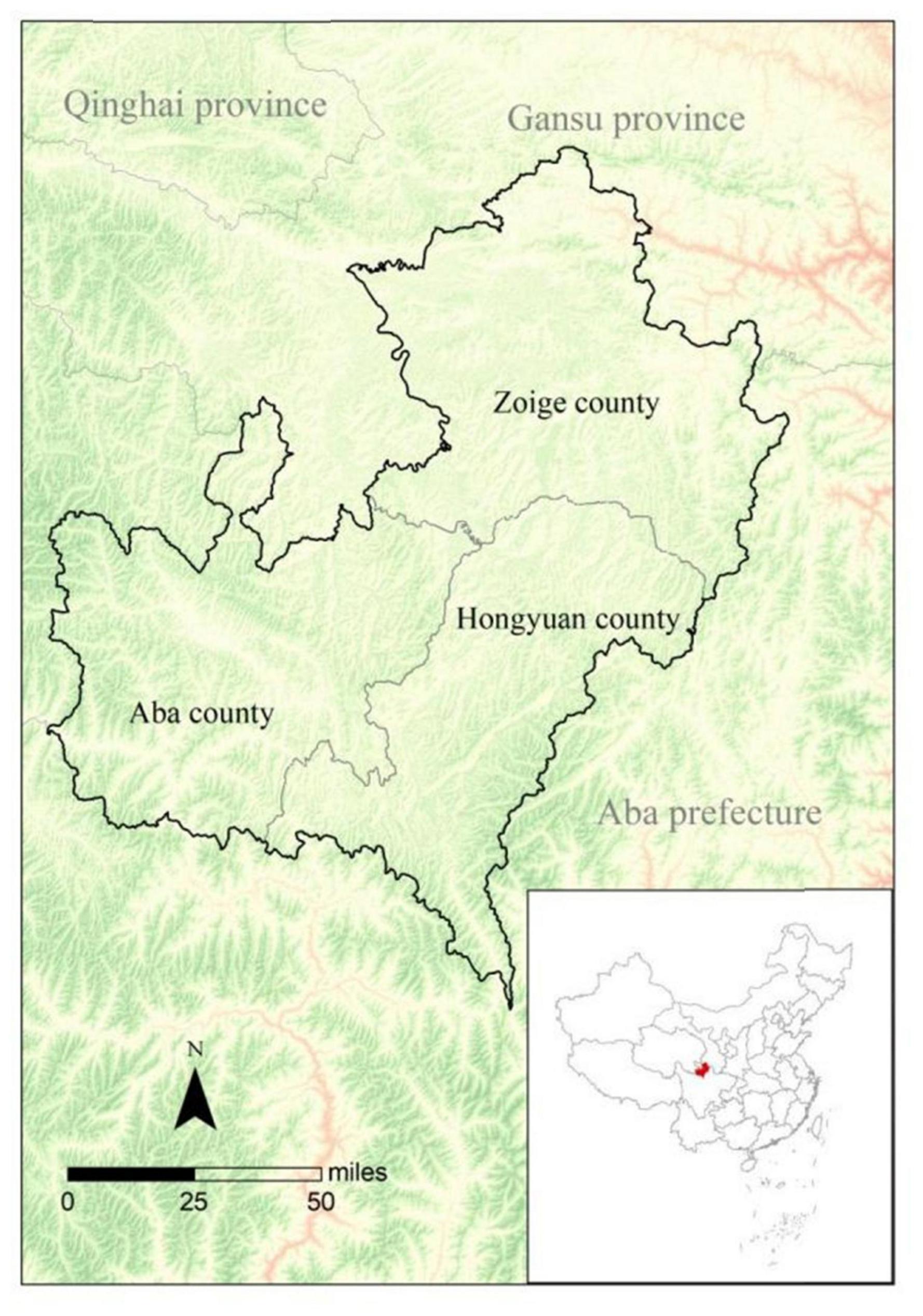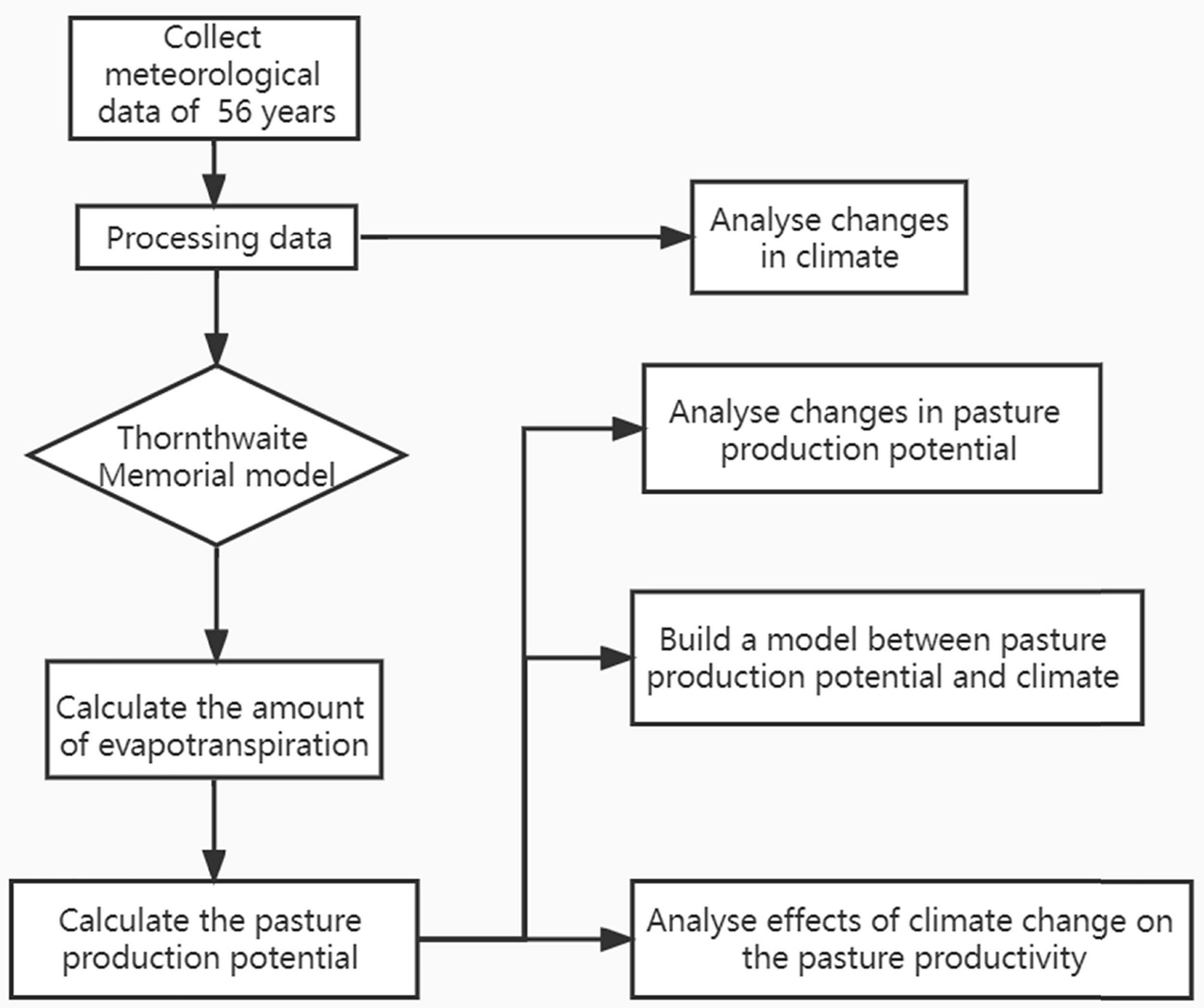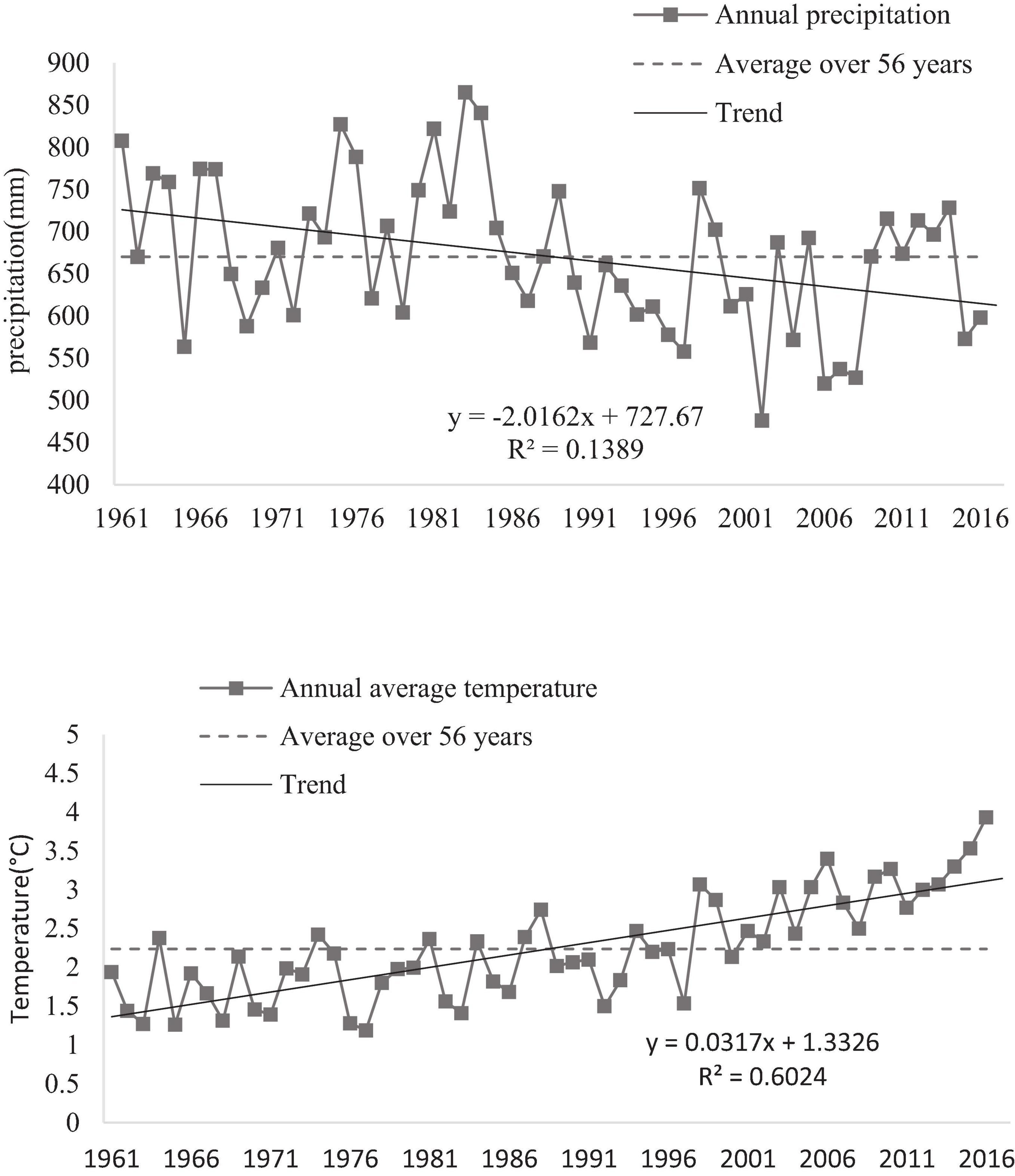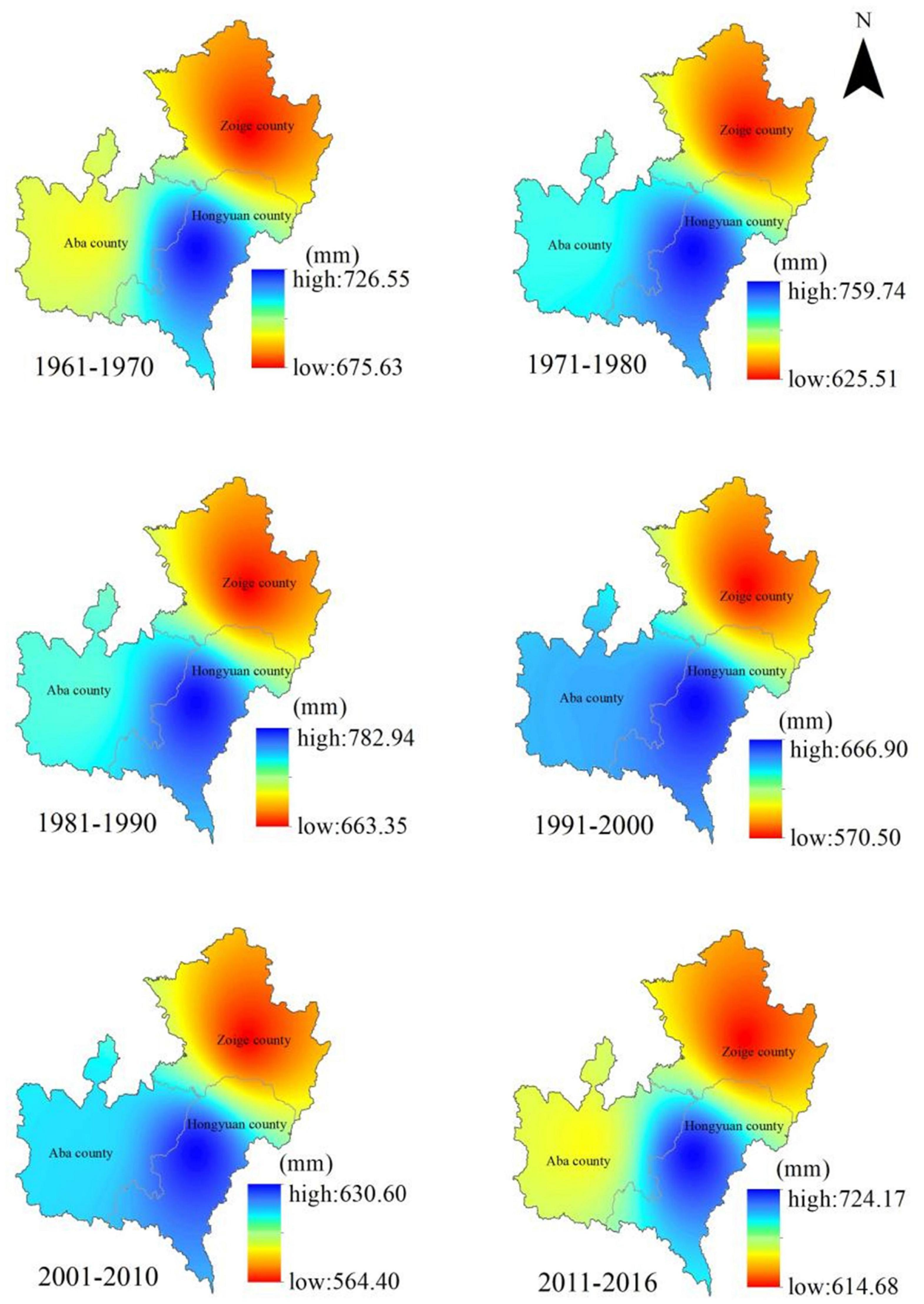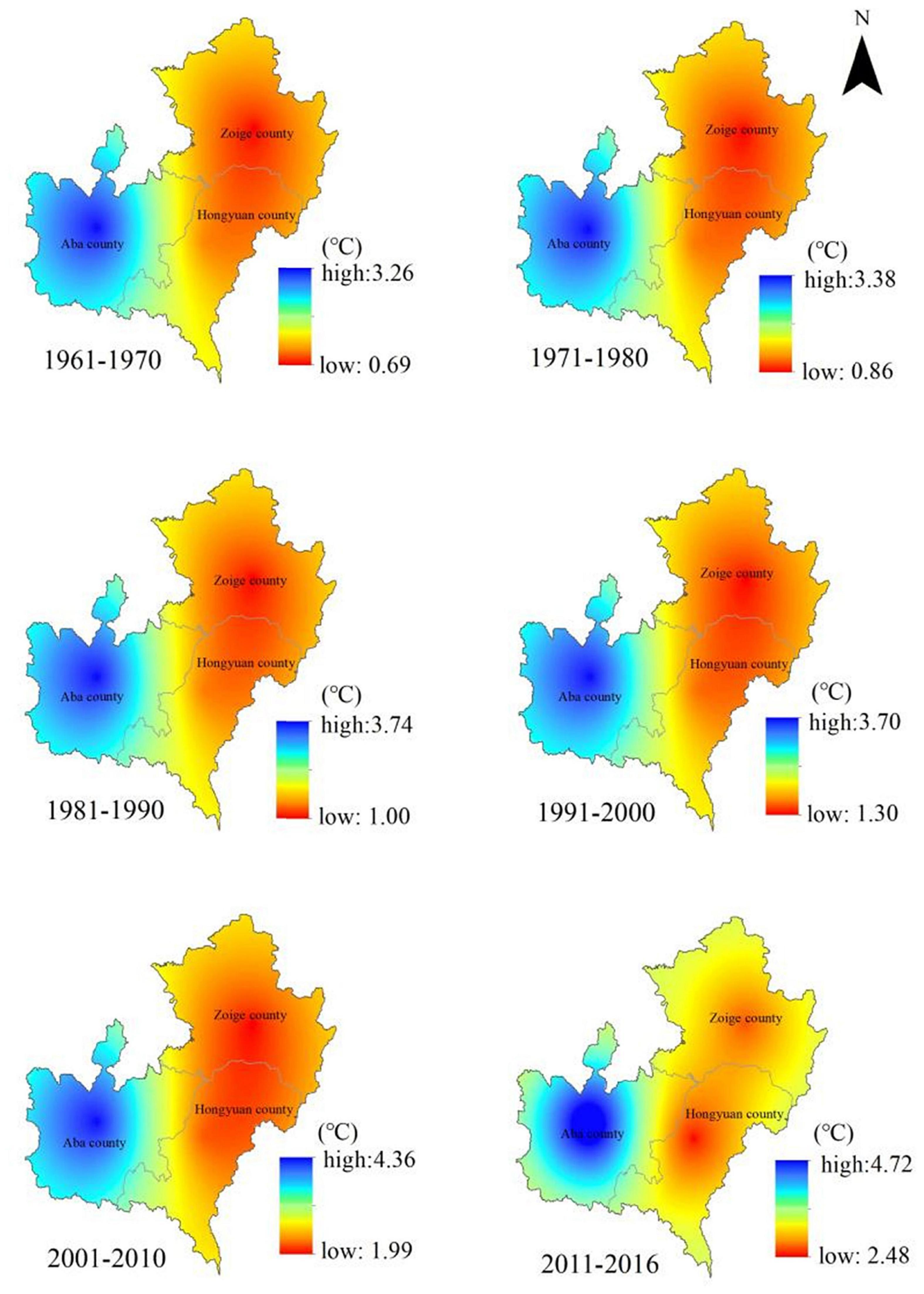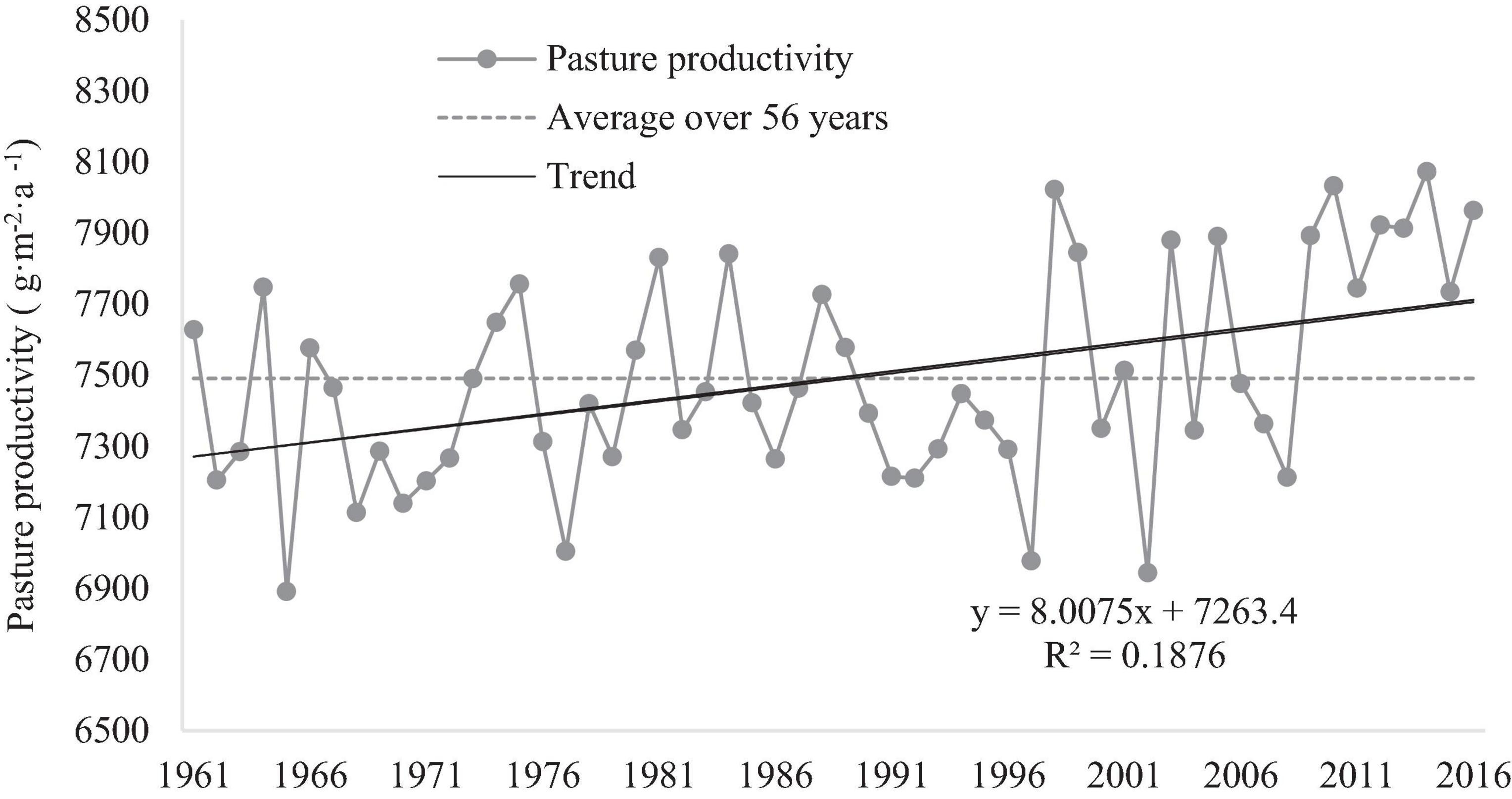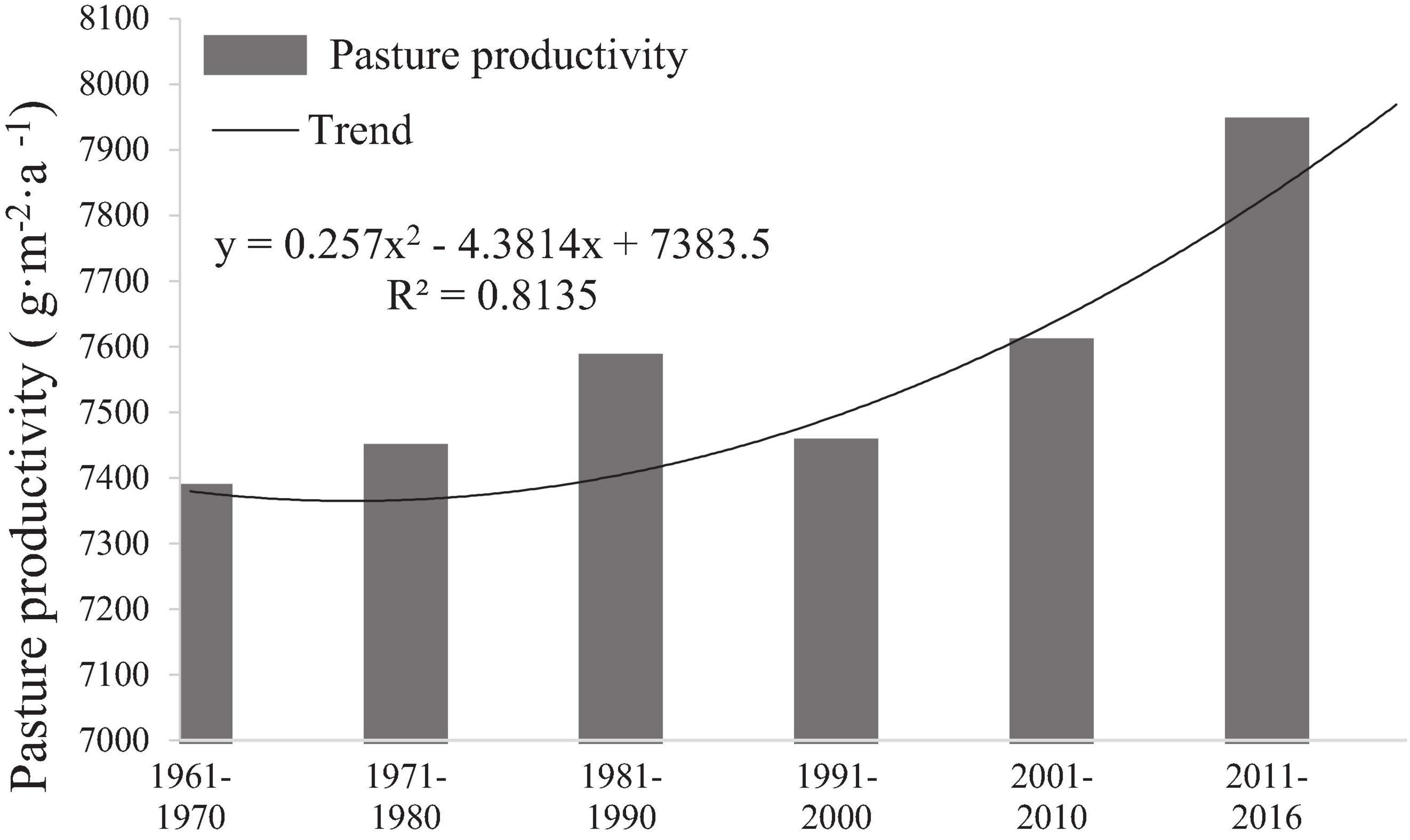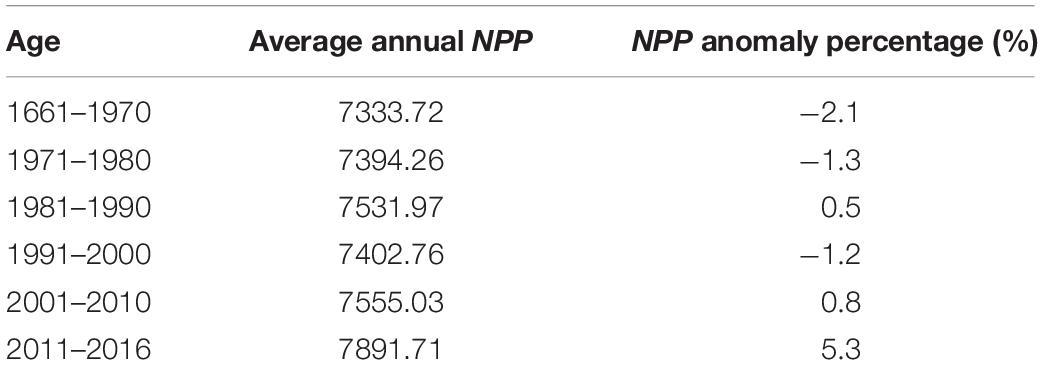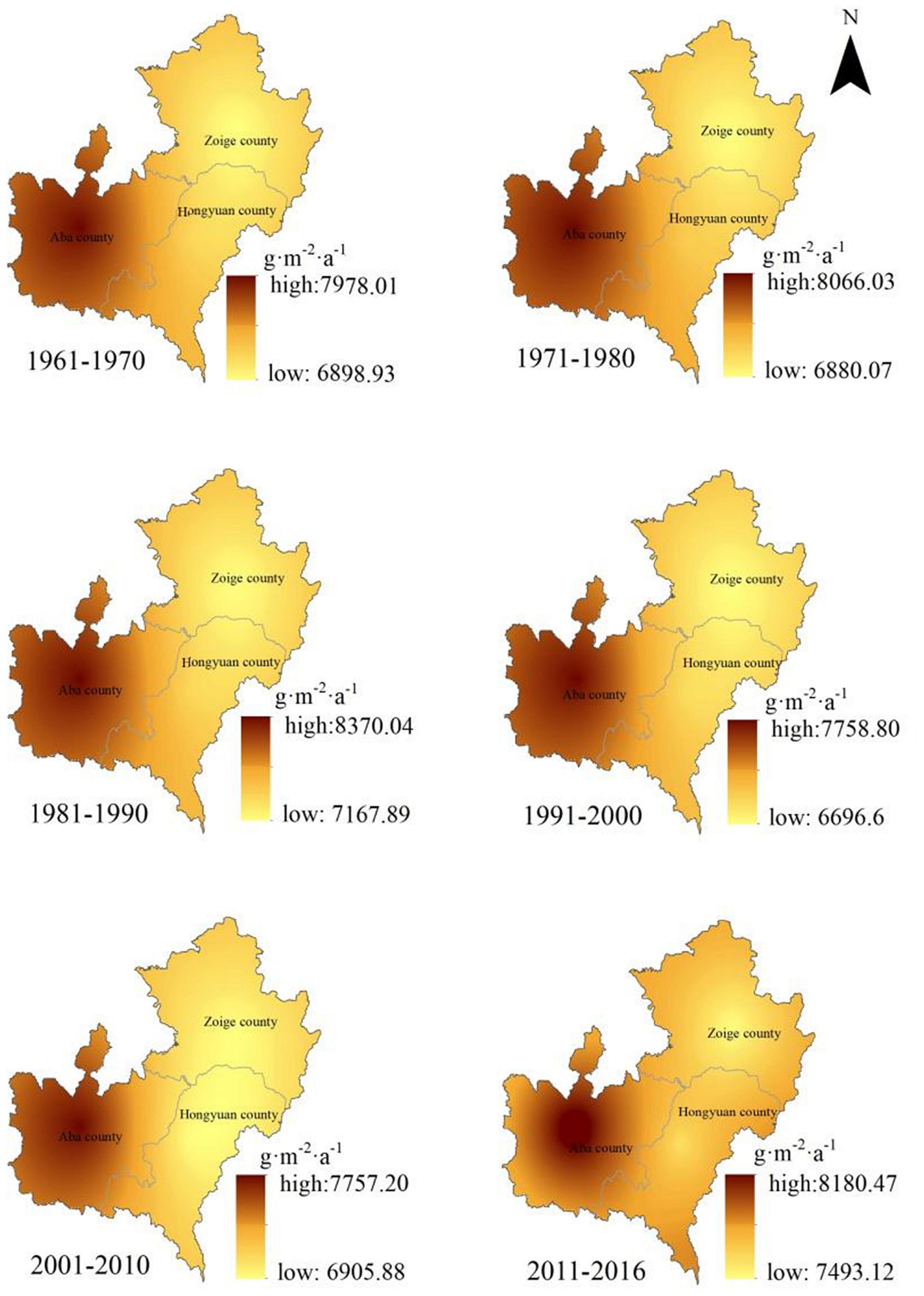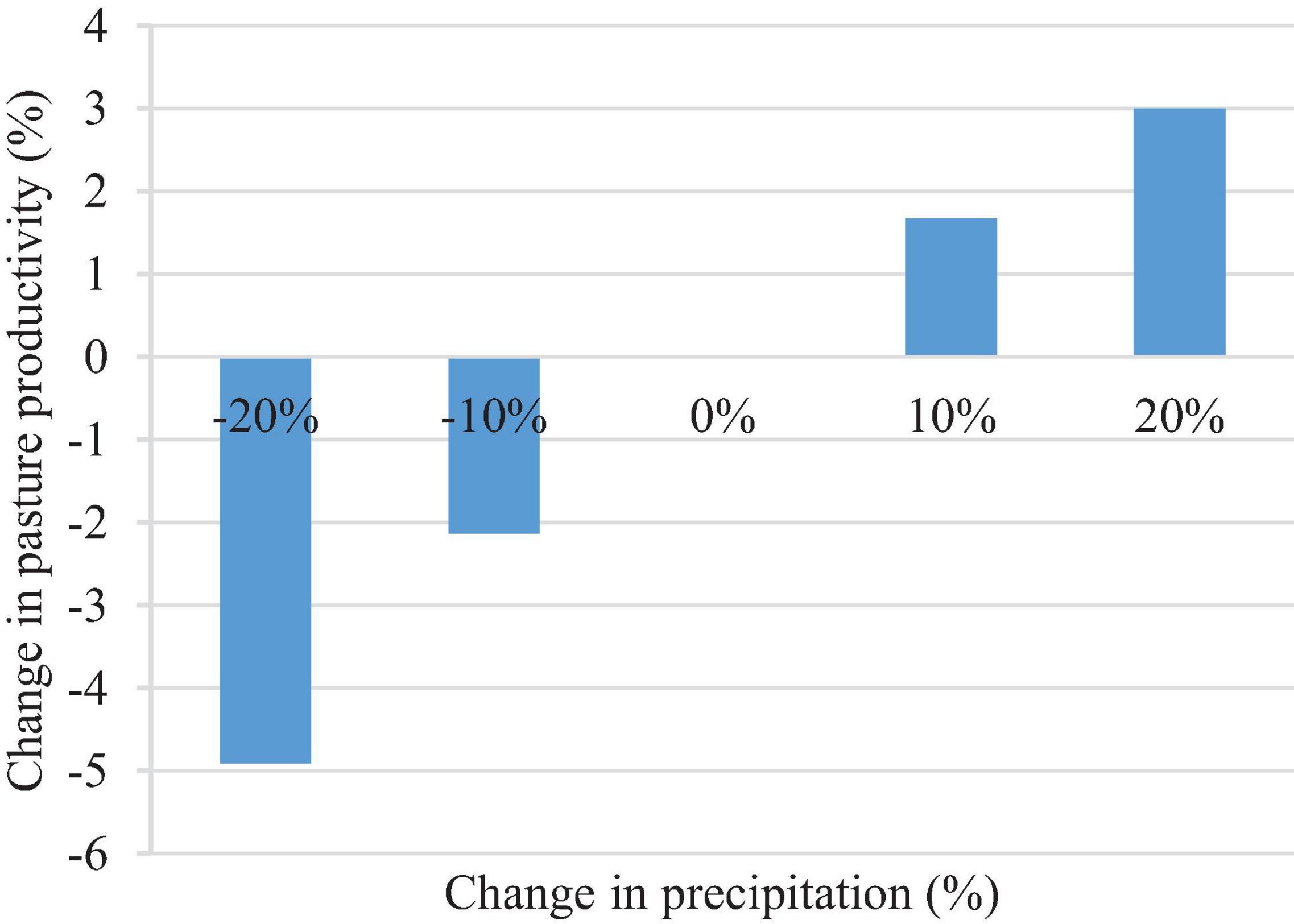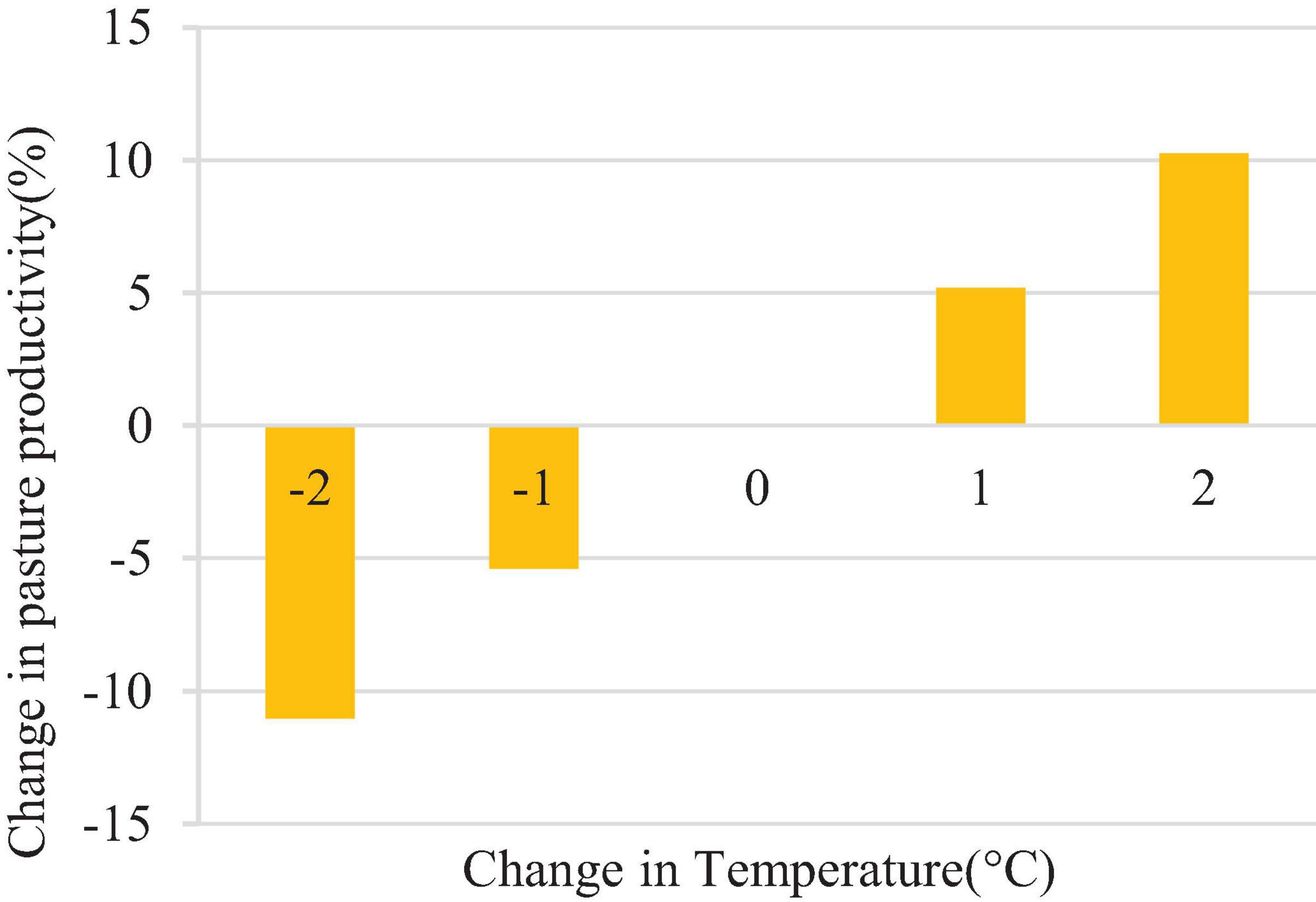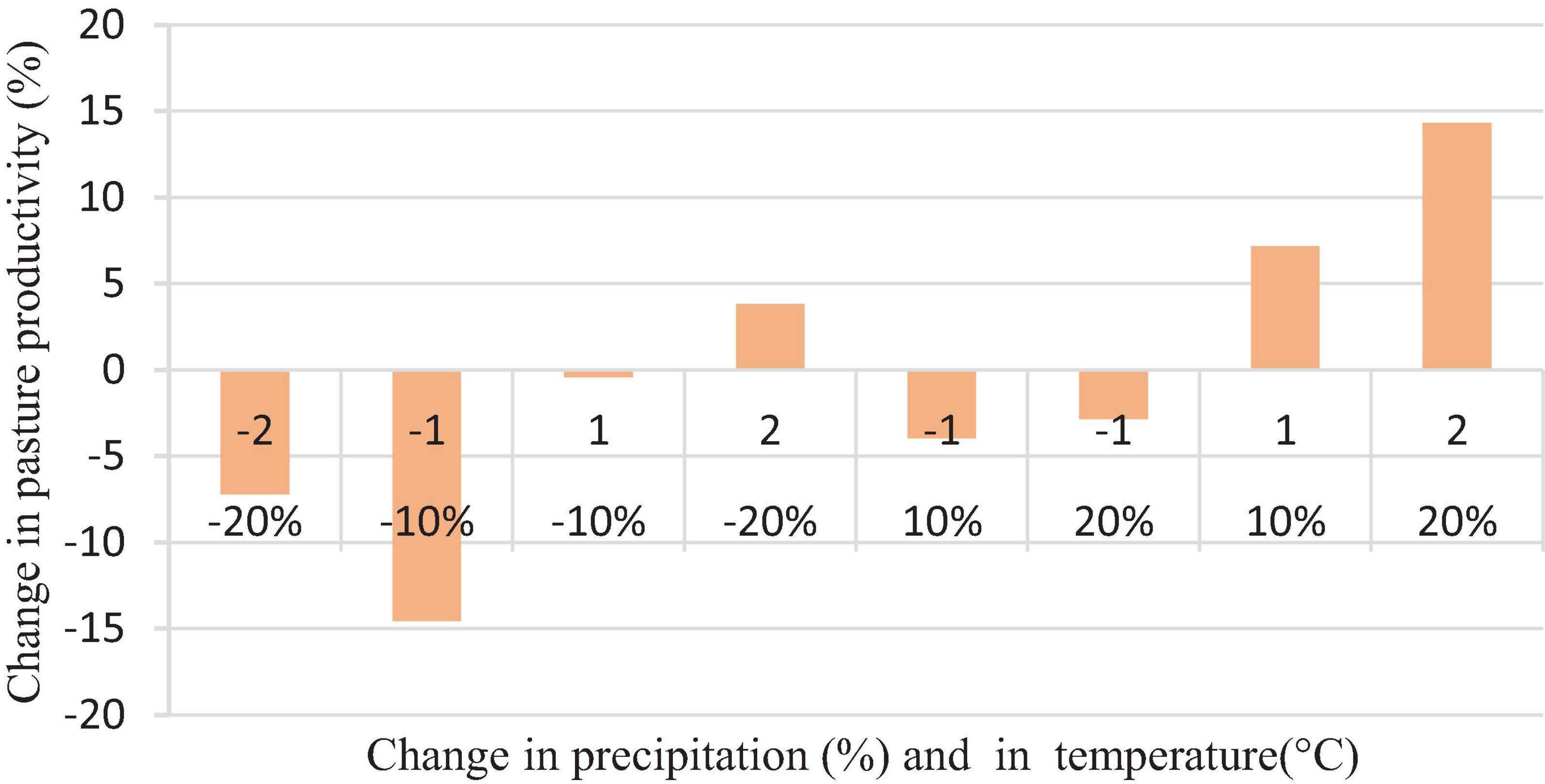- 1Sichuan Institute of Land Science and Technology (Sichuan Satellite Application Technology Center), Chengdu, China
- 2Information Center of Department of Natural Resources of Sichuan Province, Chengdu, China
- 3Institute of Mountain Hazards and Environment, Chinese Academy of Sciences, Chengdu, China
- 4Sichuan Land Consolidation and Rehabilitation Center, Chengdu, China
- 5College of Earth Sciences, Chengdu University of Technology, Chengdu, China
- 6Sichuan Environment and Engineering Appraisal Center, Chengdu, China
- 7China Southwest Geotechnical Investigation and Design Institute Co. Ltd., Shanghai, China
- 8Chongqing Jiaotong University, Chongqing, China
Meteorological station data from 1961 to 2016 in the Sichuan Yellow River Source (SYRS) was used to analyze the trends in precipitation and temperature. The Thornthwaite Memorial model and GIS technology were used to calculate the response of pasture productivity to climate change. A climate prediction model of pasture productivity was established to predict its response to precipitation and temperature. The results showed that: (1) the annual precipitation presents a slight downward trend, at a rate of −10.16 mm⋅(10a)–1. The average annual temperature exhibited an upward trend, at (10a)–1, and the productivity of herbage exhibited a linearly increasing trend, with a rate of increase of 80.07 g⋅m–2⋅(10a)–1. (2) In terms of spatial distribution, the pasture productivity decreased from southwest to northeast. The influence of temperature on pasture productivity was greater than that of precipitation in the SYRS. (3) The “warm-wet” climate was conducive to increasing pasture productivity. The annual average temperature was predicted to increase by 1 or 2°C, and the annual average precipitation was predicted to increase by 10 or 20% with an average increase between 7.15 and 14.30%. (4) Grassland degradation continues to occur and ecological restoration measures should be implemented to control grassland degradation.
Introduction
Since the twentieth century, the world has experienced significant effects of global warming. According to the Fifth Assessment Report of the IPCC, the average temperature of the world has increased by 0.85°C from 1880 to 2012. In the Northern Hemisphere, the 30 years with the highest temperature in the past 1,400 years was 1983–2012 (Shen and Wang, 2013). Short- and long-term fluctuations in the temperature and moisture of the surrounding environment are the main reasons for changes in the pasture productivity in a given region (Wu, 2002). It is important to notethat even low levels of climate change can lead to functional destruction and structural changes in vegetation and vegetation zones (Song et al., 2012). Yi et al. (2012) adopted the total deficit method to identify climatic factors affecting pasture productivity from observed data, exploring how extreme climate events change the productivity of an ecosystem.
Grassland accounts for 1/3 of China’s land area and is an important barrier in terrestrial ecosystems. As an important part of the ecological barrier of the Qinghai-Tibet Plateau and the “Water tower of China,” the source region of the Yellow River is one of 34 hotspots with the richest biodiversity in the world. It plays an extremely important role in maintaining national ecological security. The models used to calculate the climatic pasture productivity include the biogeochemical ecosystem model, Jiang Ai-liang model, Miami model, and Thornthwaite Memorial model (Zhao, 2007; Berberoglu et al., 2021; Huang et al., 2021). Berberoglu et al. (2021) used a biogeochemical ecosystem model, the Carnegie–Ames–Stanford Approach (CASA) model, to forecast the annual net primary productivity (NPP) changes for the periods 2000–2010 and 2070–2080. Cheng and Yin (2022) used the Thornthwaite Memorial model to analyze the climatic productivity, population carrying capacity, and its index in eastern Gansu. They revealed the relationship between population and grain growth in eastern Gansu. Huang et al. (2021) estimated the potential and actual NPP in Anji based on the Thornthwaite Memorial model, CASA model, and multiple linear regressions. HANPPluc significantly increased from 1984 to 2014. The comprehensive estimation model of climatic productivity is also used to analyze the spatiotemporal distribution of climatic productivity in China (Cao et al., 2020). On the Tibetan Plateau, the climatic productivity has shown significant spatiotemporal differences over the past 50 years. From 1965 to 2013, the climatic productivity of herbage on the Qinghai-Tibet Plateau increased from northwest to southeast. The climatic productivity of herbage in the northern and southern parts of Qinghai Province increased significantly, while that in the eastern part of Tibet increased only slightly, and the differences between the northern and southern regions were large (Zhao et al., 2016). In Ningxia, with increases in temperature and precipitation, the climatic production exhibited an increasing trend (Duan et al., 2014). The Three-River-Source experiences a dry climate, and precipitation is the key factor affecting grassland climate production in the region (Guo et al., 2008).
The Miami model considers precipitation and temperature as climate factors, while the Thornthwaite Memorial model considers temperature, precipitation, and evapotranspiration (Zhao, 2007). The Thornthwaite Memorial model results are consistent in that precipitation and temperature are the key factors affecting the growth and development of herbage in this area. The objectives of this study are as follows: (1) to elucidate the spatiotemporal variations in the pasture productivity in the study area based on long-term climate factors, and (2) to establish a climate prediction model for pasture productivity, clarifying the impact of climate change on the pasture productivity and proposing measures to improve the productivity of grassland vegetation.
Materials and Methods
Study Area
The SYRS is located on the east margin of the Tibetan plateau (Figure 1). The research location is the SYRS, which primarily comprises the Hongyuan, Aba, and Zoige counties of the Aba Tibetan and Qiang Autonomous Prefecture, covering an area of 29,161 km2. The main geomorphic types are alpine, hilly plateau, and terrace. Natural grassland is the main type of grassland, covering an area of 16,735 km2 and accounting for 79.85% of the total grassland area. Meanwhile, marsh grassland covers 3,964 km2, accounting for 20.12%. The study area experiences a sub-humid monsoon climate in the cold temperate zone of the plateau, which is a typical ecologically fragile area, sensitive to local and global climate change.
Data Source
The meteorological data are obtained from the China Meteorological Data Sharing Service Network1 ground climate data, including the monthly average temperature, average precipitation, etc. from 1961 to 2016.
Methods
First, the meteorological data for the past 56 years were collected. Second, the data were processed to analyze the trends in precipitation and temperature in the source area of the Yellow River. Then, a model was used to calculate the evapotranspiration, while calculating the pasture productivity. A model was constructed to describe the relationship between climate and pasture productivity, which is an important part of this research. Finally, we analyzed the impact of climate change on pasture productivity (Figure 2).
The Pasture Productivity
The pasture productivity is affected by the joint action of the pasture’s genetic traits and environmental factors during the growth period. If other factors remain unchanged, the climatic conditions during the growth period have the greatest influence on the yield (Zhao, 2007). The Thornthwaite Memorial model (Yang and Piao, 2006; Liu et al., 2014) estimated the pasture productivity in the study area as follows:
Where T_P is the pasture productivity, g.m–2.a–1; V is the annual average actual evapotranspiration, mm; T is the annual average temperature, °C; L represents the empirical function of the annual average temperature; and P is the average annual precipitation, mm.
Grassland Degradation Index
Grasslands have many service functions, including soil and water conservation and biodiversity maintenance (Tang et al., 2022). Furthermore, their carbon sequestration is huge, which has an important regulatory effect on the global climate and ecosystem carbon cycle (Zhao et al., 2018). Based on remote-sensing data and meteorological data, the NPP in the study area was calculated. From the perspective of the carbon sequestration status of the ecosystem, the issue of grassland degradation in the region was discussed, the optimal productivity value in the region was selected as the reference ecosystem, and the grassland productivity NPPreal in the study area was compared with the NPPmax of the reference ecosystem productivity to obtain the degree of degradation.
The grassland degradation index (GDI) was calculated as follows:
where NPPreal represents the NPP within the assessment unit and NPPmax is the ideal NPP or maximum NPP of the intact grassland within the unified physical geographic zone and the assessment unit.
Results
Spatial and Temporal Trends in Climate
Temporal Trends in Climate
Over the past 56 years, the temperature has exhibited an increasing trend (Figure 3), with a warming of 0.32°C⋅(10a)–1 in the SYRS. From the trend line, it can be seen that the temperature generally lies below the average from 1961 to 1997, and has been increasing since 1997. Precipitation displayed a decreasing trend in general. However, this decrease was small, with a propensity rate of 10.16 mm⋅(10a)–1. The precipitation in 2002 reached the minimum value of 476 mm.
Spatial Variation of Climate
The spatial distribution of average annual precipitation (Figure 4) and average annual temperature (Figure 5) from 1961 to 2016 showed a decreasing trend from southwest to northeast. Within the study location, Aba County had the highest temperature, with an increase of 1.46°C in the average temperature from 2011 to 2016 compared to the 1961–1970 average temperature. The overall precipitation was generally above 500 mm, with a decrease in the twenty-first century compared to the 1960s. Precipitation was most abundant in Hongyuan, but the temperature was low. Aba County had sufficient precipitation to meet the needs of forage growth and higher temperature, showing a trend of warming and humidification; this is to say, a “warm-wet” climate.
Spatial and Temporal Variation in Pasture Productivity
Interannual Variation in Pasture Productivity
Over the past 56 years, the pasture productivity in the SYRS exhibited an overall upward trend (Figure 6). The overall change was from 6891.95 to 8073.16 g⋅m–2, with an increase of 80.07 g⋅m–2⋅(10a)–1, and the average value was 7491.56 g⋅m–2. The pasture productivity increased the most from 1997 to 1998, with a change of 1044.17 g⋅m–2. Since 2008, the pasture productivity has been higher than the average, but the increase has been slow.
Interdecadal Variation in Pasture Productivity
From the 1960s to 2016, the pasture productivity in the SYRS exhibited an overall increasing trend (Figure 7). It was negative in the 1990s. Since the twenty-first century, the pasture productivity has increased significantly. In comparison to the average value over the past 56 years, the pasture productivity in the 1960s, 1970s, and 1990s was 2.1, 1.3, and 1.2% lower than the average value, respectively, and 0.5% higher than the average value in the 1980s, 0.8% higher than the average value in the 2000s, and 5.3% higher than the average value from 2011 to 2016 (Table 1).
Interdecadal Spatial Variation in Pasture Productivity
The spatial distribution of pasture productivity in the SYRS was significantly different (Figure 8), decreasing from southwest to northeast. The area with the highest value was in Aba County, with a maximum of 7978.01 g⋅m–2⋅a–1 in the 1960s and a maximum of 8180.47 g⋅m–2⋅a–1 from 2011 to 2016. The lowest value occurred in Zoig County, with a minimum of 6898.83 g⋅m–2⋅a–1 in the 1960s and 7449.12 g⋅m–2⋅a–1 from 2011 to 2016. A comparison of pasture productivity in 1961–1970 and 2011–2016 indicated an increasing trend due to the significant increase in temperature, but this increase was restrained by the faint decrease in precipitation. Pasture productivity in the SYRS was increased overall.
Effects of Climate Change on the Pasture Productivity in Climate Scenarios
From the meteorological data over 56 years, it can be seen that the temperature in the SYRS exhibited an overall upward trend while the precipitation fluctuated from year to year. Therefore, this study assumes that, in the SYRS, the annual average temperature increases or decreases by 1 or 2°C, and the annual average precipitation increases or decreases by 10 or 20%. Given these assumptions, the percentage change in pasture productivity was predicted (Table 2).
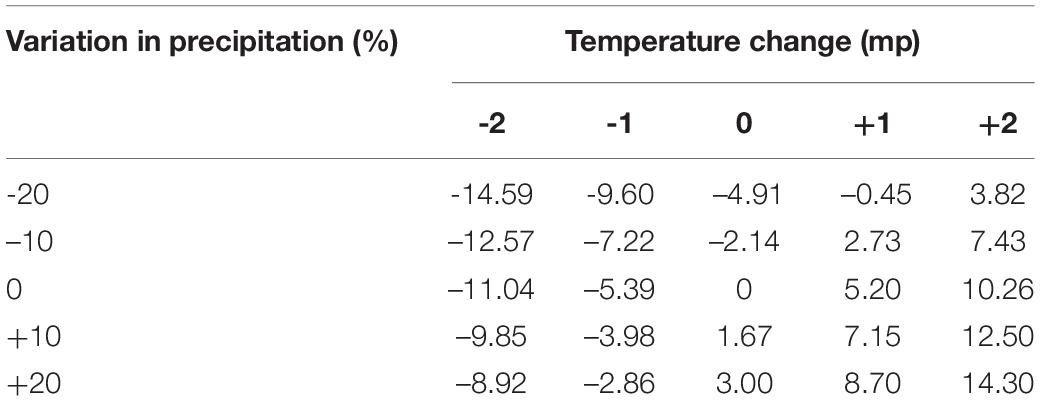
Table 2. Predicted percentage change on pasture productivity based on changes in the annual mean temperature and annual precipitation in the SYRS.
Effects of Precipitation Change on the Pasture Productivity in Climate Scenarios
Assuming that the average annual temperature remained unchanged at the average level over 56 years, the pasture productivity would increase by 1.67 and 3% when the precipitation increased by 10 and 20%, respectively. The pasture productivity was predicted to decrease by 2.14 and 4.91% when the precipitation decreased by 10 and 20%, respectively (Figure 9).
Effects of Temperature Change on the Pasture Productivity in Climate Scenarios
If the average annual precipitation remains unchanged at the average level over 56 years, the pasture productivity will increase by 5.20 and 10.26% when the temperature increases by 1 and 2°C, respectively. The pasture productivity was predicted to decrease by 5.39 and 11.04% when the temperature decreased by 1 and 2°C, respectively (Figure 10). This shows that the influence of temperature change on the pasture productivity was greater than that of precipitation in the SYRS.
Combined Effects of Precipitation and Temperature on Pasture Productivity in Climate Scenarios
If the annual precipitation increased by 10% and the annual mean temperature increased by 1°C, the pasture productivity would increase by 7.15%. Meanwhile, if the annual precipitation increased by 20% and the annual mean temperature increased by 2°C, the pasture productivity would increase by 14.30% (Figure 11). Therefore, the “warm-wet” climate is beneficial to improving the pasture productivity.
Given a 10% decrease in the annual precipitation decreased and a 1°C decrease in the annual mean temperature, the pasture productivity would decrease by 7.22%. If the annual precipitation decreased by 20% and the annual mean temperature decreased by 2°C, the pasture productivity would decrease by 14.59% (Figure 11). This shows that a “cold-dry” climate has significant negative effects on the pasture productivity in the SYRS.
If the precipitation decreased by 10% and the average annual temperature increased by 1°C, the pasture productivity would decrease by 0.45%. If the precipitation decreased by 20% and the average annual temperature increased by 2°C, the pasture productivity would increase by 3.82%. If the precipitation increased by 10% and the annual average temperature decreased by 1°C, the pasture productivity would decrease by 3.98%. If the precipitation increased by 20% and the annual mean temperature decreased by 1°C, the pasture productivity would decrease by 2.86% (Figure 11). Compared to the “warm-wet” and “cold-dry” climates, the “warm-dry” and “cold-wet” climates have less influence on pasture productivity in the SYRS.
Discussion
The rising global temperatures and decreasing precipitation have significant impacts on terrestrial ecosystem productivity and its spatiotemporal distribution (Cao et al., 2020). From the analysis of spatial and temporal variations in climate and pasture productivity, it can be concluded that over the past 56 years, precipitation demonstrated a decreasing trend and temperature exhibited an increasing trend, with a warming of 0.32°C⋅(10a)–1. The spatial distribution of average annual precipitation and average annual temperature showed a decreasing trend from southwest to northeast in the SYRS.
The temperature has a significant influence on the Tibetan Plateau at high altitudes and latitudes (Cao et al., 2020). The research results of Guo et al. (2008) show that the 1960s and 1970s experienced a “cold-wet” climate, the 1980s experienced a “warm-wet” climate, the 1990s experienced a “warm-dry” climate, and the first 6 years of the twenty-first century experienced a “warm-wet” climate in Yellow River Source. In terms of the response of pasture productivity to climate change, many researchers have found that climate change has an impact on the pasture productivity (Gao et al., 1994; Zhou et al., 1997; Yao et al., 2004). The Aba-Hongyuan-Zoige grassland is one of the three major grassland pastoral areas in China and is also one of the best natural pastures in Asia. According to the climate prediction model of pasture productivity, it can be concluded that the influence of temperature change on the pasture productivity was greater than that of precipitation in the SYRS. The “warm-wet” climate is good for herbage growth and will be favorable for improving the pasture productivity, while the “cold-dry” climate is detrimental to herbage growth and will be the most unfavorable for pasture productivity in the SYRS. Due to global climate change and human activities, pasture productivity has changed significantly and exhibited a linearly increasing trend, with an increase rate of 80.07 g⋅m–2⋅(10a)–1 in the SYRS over the past 56 years.
Owing to the significant increase in temperature, the potential pasture productivity of the entire region exhibited an increasing trend; however, this trend was restrained by the decrease in precipitation. Furthermore, in recent decades, due to the influence of natural and human factors such as global temperature increases and overgrazing, grassland degradation has continued and there is a risk of reverse succession into rat wasteland and sandy land. The grassland carry the survival and life of local residents (Yu et al., 2020a), and bearing pressure on the grasslands has been steadily increasing with the development of the social economy (Yu et al., 2021). This not only affects the livestock industry but also poses challenges for ecological security (Pan and Li, 1996; Ren et al., 2011; Zhou et al., 2014). Restoring degraded grassland ecosystems plays an important role in improving grassland ecosystem service functions (Yu et al., 2020b). Therefore, ecological restoration measures should be implemented in the region as soon as possible to control grassland degradation, with the restoration of grassland vegetation as the main goal. This will improve the grassland structure and the pasture productivity.
Conclusion
Based on the Thornthwaite Memorial model, the pasture productivity over the past 56 years was calculated and the key factors affecting the pasture productivity were obtained in the SYRS. A regression model between the climatic factors and pasture productivity was established to predict the effects of specific changes in precipitation and temperature on pasture productivity. The main conclusions are as follows.
(1) Over the past 56 years, the annual precipitation exhibited a weak downward trend, with a rate of decrease of 10.16 mm (10a)–1. The average annual temperature presented an upward trend, with a rate of increase of 0.32°C (10a)–1. The spatial distribution of average annual precipitation and temperature showed a decreasing trend from southwest to northeast in the SYRS.
(2) The pasture productivity exhibited a linearly increasing trend, with a rate of increase of 80.07 g⋅m–2⋅(10a) –1. The spatial distribution of the pasture productivity was significantly varied, decreasing from the southwest to the northeast. The influence of temperature change on pasture productivity was greater than that of precipitation in the SYRS.
(3) The “cold-dry” climate has negative effects, while the “warm-wet” climate has positive effects on the pasture productivity. According to the climate prediction model of pasture productivity, if the annual precipitation increases by 10% and the annual mean temperature increases by 1°C, the pasture productivity increases by 7.15%. Meanwhile, if the annual precipitation increases by 20% and the annual mean temperature increases by 2°C, the pasture productivity increases by 14.30%.
(4) The SYRS is an important part of the ecological barrier of the Qinghai-Tibet Plateau, with a fragile ecological environment. Grassland degradation continues to occur; therefore, the restoration of degraded grassland is imperative. In addition, desertification control and “three-hazard” prevention are crucial for improving the grassland structure, vegetation productivity, and animal husbandry in the SYRS.
Data Availability Statement
The original contributions presented in this study are included in the article/supplementary material, further inquiries can be directed to the corresponding authors.
Author Contributions
LZ, SL, and YoL: methodology, data collection, data analysis, and writing of all drafts. PX, HY, TZ, and LY: methodology, data collection, review, and editing of drafts. HY, YH, and XW: conceptualization, investigation, and funding acquisition. WD and HH: methodology, review and editing of drafts, and supervision. DW, KL, and YiL: data collection, validation, review, and editing of drafts. All authors contributed to the article and approved the submitted version.
Funding
This research was funded by the Sichuan Science and Technology Program (Grant Nos. 2022YFS0494 and 2019YFS0467) and the National Natural Science Foundation of China (Grant No. U20A2088).
Conflict of Interest
XW was employed by China Southwest Geotechnical Investigation and Design Institute Co., Ltd.
The remaining authors declare that the research was conducted in the absence of any commercial or financial relationships that could be construed as a potential conflict of interest.
Publisher’s Note
All claims expressed in this article are solely those of the authors and do not necessarily represent those of their affiliated organizations, or those of the publisher, the editors and the reviewers. Any product that may be evaluated in this article, or claim that may be made by its manufacturer, is not guaranteed or endorsed by the publisher.
Footnotes
References
Berberoglu, S., Donmez, C., and Cilek, A. (2021). Modelling climate change impacts on regional net primary productivity in Turkey. Environ. Monit. Assess. 193:242. doi: 10.1007/s10661-021-09031-z
Cao, D., Zhang, J. H., Yan, H., Xun, L., Yang, S. S., Bai, Y., et al. (2020). Regional Assessment of Climate Potential Productivity of Terrestrial Ecosystems and Its Responses to Climate Change Over China From 1980-2018. IEEE Access 8, 11138–11151. doi: 10.1109/ACCESS.2019.2963458
Cheng, J. Q., and Yin, S. Y. (2022). Evaluation of Population–Food Relationship from the Perspective of Climate Productivity Potential: a Case Study of Eastern Gansu in Northwest China. Atmosphere 13, 287–287. doi: 10.3390/atmos13020287
Duan, X. F., Zhang, L., Wei, J. G., Zhu, Y. N., Yang, Y., and Jin, F. (2014). Prediction of herbage recovery stage and preliminary analysis of its production potential in Yanchi. Ningxia. Acta Prataculturae Sin. 23, 1–5. doi: 10.11686/cyxb20140201
Gao, S. H., Pan, Y., and Guo, J. P. (1994). Climatic change to plant climate productive forces influence. Meteorol. Monthly 20, 30–33.
Guo, L. Y., Wu, R., Wang, Q. C., and Ji, S. M. (2008). Effects of climate change on the climate production potential of grassland in the source of the Three Rivers of Xinghai County. Chin. J. Grassl. 30, 5–10.
Huang, Y., Chen, S. L., Jiang, H., Chen, W. J., and Mo, X. H. (2021). Assessment of the impact of land use changes on net primary productivity using human appropriation of net primary productivity in Anji, China. Appl. Ecol. Environ. Res. 19, 4331–4348.
Liu, S. Y., Zhang, L., Wang, C. Z., Yan, M., Zhou, Y., and Lu, L. L. (2014). Vegetation phenology in the Tibetan Plateau using MODIS data from 2000 to 2010. Remote Sens. Inform. 29, 25–30. doi: 10.3969/j.issn.1000-3177.2014.06.006
Pan, B. T., and Li, J. J. (1996). Qinghai-Tibetan Plateau: a driver and amplifier of the global climatic change (III): the effects of the uplift of Qinghai-Tibetan Plateau on climatic changes. J. Lanzhou Univ. 32, 108–115. doi: 10.13885/j.issn.0455-2059.1996.01.024
Ren, J. Z., Liang, T. G., Lin, H. L., Huang, X. D., Hou, F., Zou, D. F., et al. (2011). Study on grassland’s responses to global climate change and its carbon sequestration potentials. Acta Prataculturae Sin. 20, 1–22. doi: 10.11686/cyxb20110201
Shen, Y. P., and Wang, G. Y. (2013). Key findings and assessment results of IPCC WGI fifth assessment report. J. Glaciol. Geocryol. 35, 1068–1076. doi: 10.7522/j.issn.1000-0240.2013.0120
Song, C., Pei, T., and Zhou, C. H. (2012). Research progresses of surface temperature characteristic change over Tibetan Plateau since 1960. Prog. Geogr. 31, 1503–1509.
Tang, X. Y., Wu, H., Dong, J. W., Liu, X. Y., Li, W., and Cui, Y. P. (2022). Effects of desertification and degradation status on carbon sequestration in grassland ecosystems in southern Gansu. J. Ecol. 41, 278–286.
Wu, Z. F. (2002). Ecological climatology of vegetation transition zone in Northeast China. Geogr. Sci. 22, 219–224. doi: 10.3969/j.issn.1000-0690.2002.02.016
Yang, Y. H., and Piao, S. L. (2006). Variations in grassland vegetation cover in relation to climatic factors on the Tibetan Plateau. J. Plant Ecol. 30, 1–8. doi: 10.3321/j.issn:1005-264X.2006.01.001
Yao, Y. B., Zhang, X. Y., Zhu, G. Q., Wang, W. T., Li, Q. Z., and Pei, Y. C. (2004). Assessment of climatic productivity of herbage for natural grass lands in the northeastern Qinghai-Tibet Plateau. Chin. J. Agrometeorol. 25, 32–34. doi: 10.3969/j.issn.1000-6362.2004.01.009
Yi, C. X., Rustic, G., Xu, X. Y., Wang, J. X., Dookie, A., Wei, S. H., et al. (2012). Climate extremes and grassland potential productivity. Environ. Res. Lett. 7:035703. doi: 10.1088/1748-9326/7/3/035703
Yu, H., Liu, B. T., Wang, G. X., Zhang, T. Z., Yang, Y., Lu, Y. Q., et al. (2021). Grass-livestock balance based grassland ecological carrying capability and sustainable strategy in the Yellow River Source National Park. Tibet Plateau, China. J. Mt. Sci. 18, 2202–2212. doi: 10.1007/s11629-020-6087-2
Yu, H., Wang, G. X., Yang, Y., and Lü, Y. Q. (2020a). Concept of grassland green carrying capacity and its application framework in national park. Acta Ecol. Sin. 40, 7248–7254. doi: 10.5846/stxb201906171276
Yu, H., Wang, G. X., Yang, Y., Bai, Z. Y., Liu, B. T., Zhang, T. Z., et al. (2020b). Enhancing ecological value through sustainable food supply of grasslands in the Three-River-Source National Park. Tibet Plateau, China. Ecosyst. Serv. 46:101218. doi: 10.1016/j.ecoser.2020.101218
Zhao, H. Y. (2007). Effects of climate change on climatic productivity potential of herbage in typical steppe region. Chin. J. Agrometeorol. 3, 281–284. doi: 10.3969/j.issn.1000-6362.2007.03.011
Zhao, W., Li, L., Wang, Y. J., Li, Y., Wang, Y. F., and Wang, X. (2018). Characteristics and regional differences of carbon sequestration in typical warm (hot) grasslands in Henan. Chin. J. Appl. Ecol. 29, 1867–1875. doi: 10.13287/j.1001-9332.201806.005
Zhao, X. Y., Wan, W. Y., and Wang, W. J. (2016). Effects of climate change in the past 50 years on forage production potential and phenological period on the Qinghai-Tibet Plateau. Chin. J. Ecol. Agric. 4, 532–543. doi: 10.13930/j.cnki.cjea.151029
Zhou, G. S., Zhang, X. S., Gao, S. H., Bai, K. Z., Yan, X. D., and Zheng, Y. R. (1997). Chinese vegetation to global change response research. J. Integr. Plant Biol. 39, 879–888. doi: 10.17521/cjpe.2019.0355
Keywords: pasture productivity, climate change, Sichuan Yellow River Source (SYRS), climatic productivity, spatiotemporal variation
Citation: Zhang L, Xiao P, Yu H, Zhao T, Liu S, Yang L, He Y, Luo Y, Wang X, Dong W, He H, Wang D, Liu K and Lu Y (2022) Effects of Climate Changes on the Pasture Productivity From 1961 to 2016 in Sichuan Yellow River Source, Qinghai-Tibet Plateau, China. Front. Ecol. Evol. 10:908924. doi: 10.3389/fevo.2022.908924
Received: 31 March 2022; Accepted: 24 May 2022;
Published: 23 June 2022.
Edited by:
Dingde Xu, Sichuan Agricultural University, ChinaReviewed by:
Yu Liu, Institute of Geographic Sciences and Natural Resources Research (CAS), ChinaLi Xuedong, Shandong Jianzhu University, China
Copyright © 2022 Zhang, Xiao, Yu, Zhao, Liu, Yang, He, Luo, Wang, Dong, He, Wang, Liu and Lu. This is an open-access article distributed under the terms of the Creative Commons Attribution License (CC BY). The use, distribution or reproduction in other forums is permitted, provided the original author(s) and the copyright owner(s) are credited and that the original publication in this journal is cited, in accordance with accepted academic practice. No use, distribution or reproduction is permitted which does not comply with these terms.
*Correspondence: Hui Yu, eXVodWlAaW1kZS5hYy5jbg==; Tao Zhao, NDYyNzgyMjY1QHFxLmNvbQ==; Li Yang, Mzk4OTIwNjM3QHFxLmNvbQ==; Yong Luo, bHVveW9uZzIwMTRAY2R1dC5lZHUuY24=
†These authors share first authorship
 Lv Zhang1
Lv Zhang1 Hui Yu
Hui Yu Keli Liu
Keli Liu